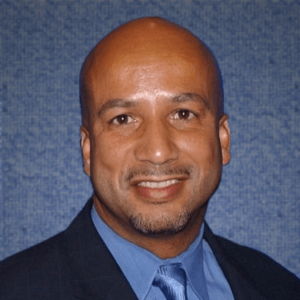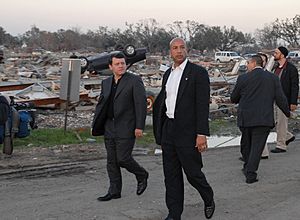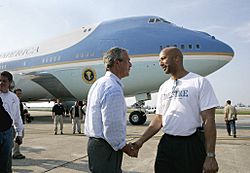Ray Nagin facts for kids
Quick facts for kids
Ray Nagin
|
|
|---|---|

Nagin in June 2006
|
|
| 60th Mayor of New Orleans | |
| In office May 6, 2002 – May 3, 2010 |
|
| Preceded by | Marc Morial |
| Succeeded by | Mitch Landrieu |
| Personal details | |
| Born |
Clarence Ray Nagin Jr.
June 11, 1956 New Orleans, Louisiana, U.S. |
| Political party | Democratic |
| Spouse |
Seletha Smith
(m. 1982) |
| Children | 3 |
| Alma mater | Tuskegee University (BS) Tulane University (MBA) |
| Signature |  |
Clarence Ray Nagin Jr. (born June 11, 1956) is a former American politician. He served as the 60th Mayor of New Orleans, Louisiana, from 2002 to 2010. As a member of the Democratic Party, Nagin became widely known in 2005 after Hurricane Katrina hit the city.
Nagin was first elected as mayor in March 2002. He won re-election in 2006. This election happened when many New Orleans citizens were still away from their homes after Hurricane Katrina. Due to rules about how long a mayor can serve, he left office on May 3, 2010.
After leaving his role as mayor, Nagin started a company called CRN Initiatives LLC. This company focused on preparing for emergencies and developing clean energy products. He also wrote a book called Katrina Secrets: Storms after the Storms.
In 2014, Nagin was found guilty of several charges related to his time as mayor. These charges involved receiving payments from city contractors. He was sentenced to ten years in federal prison.
Contents
Ray Nagin's Early Life and Career
Ray Nagin was born on June 11, 1956, in New Orleans. His family had a simple life. His father worked two jobs to support the family, first as a janitor and fabric cutter, then as a mechanic. His mother managed a restaurant inside a Kmart store.
The family lived in different parts of New Orleans. Nagin went to St. Augustine High School and O. Perry Walker High School. He played basketball and baseball there. He then attended Tuskegee University in Tuskegee, Alabama, on a baseball scholarship. He earned a degree in Accounting in 1978 and became a Certified Public Accountant.
After college, Nagin worked in the purchasing department at General Motors in Detroit, Michigan. He later moved to Los Angeles and then to Dallas for other jobs.
In 1982, Nagin married Seletha Smith, who was also from New Orleans. They have three children together. In 1985, Nagin returned to New Orleans. He became the controller for Cox New Orleans, the city's cable television company. This company had many customer complaints and low profits.
Nagin was quickly promoted to general manager. By 1989, he was in charge of all Cox properties in south Louisiana. He became vice-president and general manager of Cox Louisiana.
In 1993, Nagin went back to school at Tulane University to get his Master of Business Administration (MBA) degree. He also worked with local, state, and federal governments because his businesses needed special approvals. He became well-known because he hosted a TV show where customers could call in.
Nagin was recognized for his community work. In 1995, he received an award for diversity and being a role model. He also served on the boards of organizations like the United Way. He helped start and became president of the New Orleans chapter of 100 Black Men, a group for black businessmen.
Nagin was also part of a group that brought a hockey team, the New Orleans Brass, to the city. He became the team's president. The team was popular and played in the 18,000-seat New Orleans Arena. A local newspaper, Gambit Weekly, named Nagin "New Orleanian of the Year" that year.
Political Party Affiliation
Some news reports said that Ray Nagin was a Republican for most of his life. They said he supported George W. Bush. However, Nagin stated that he was always a Democrat. He said that news organizations that reported he was a Republican had to correct their stories. He did, however, give money to candidates from both parties at different times.
Becoming Mayor in 2002
Ray Nagin decided to run for mayor on the very last day to sign up for the race. Before the main election, two local newspapers, New Orleans Times Picayune and Gambit Weekly, supported Nagin.
In the first round of the mayoral election in February 2002, Nagin received the most votes, with 29 percent. Other candidates included Police Chief Richard Pennington and State Senator Paulette Irons. In the final election on March 2, 2002, Nagin won against Richard Pennington with 59 percent of the votes. He became the 60th mayor of New Orleans.
Mayor Nagin's First Term
During Nagin's first term, New Orleans saw many good changes. In 2004, the city gained 4,500 jobs. About 38,000 people in New Orleans moved out of poverty, while the national average increased. The income per person in New Orleans was growing faster than in any other city in the nation.
New Orleans also had two record-breaking years for tourism, with 10.1 million visitors in 2004. A poll by Yahoo and National Geographic Traveler named the city the number one family travel spot. Since 2002, over $400 million worth of movies were filmed in the area. This included the Oscar-winning movie Ray, starring Jamie Foxx. New Orleans earned the nickname "Hollywood South" for its film industry.
In November 2004, Nagin's administration approved the city's largest bond issue, which was $260 million. New Orleans also moved up on Intel's list of "Most Wired Cities," from 69th to 38th place. The city's website became the 4th best in the nation.
In September 2004, when Hurricane Ivan was heading towards the Gulf of Mexico, Nagin told people in New Orleans to get ready. He advised those who planned to stay to have food, water, and even "an axe in the attic." This was a reminder of people trapped by floodwaters during Hurricane Betsy in 1965. Nagin asked people to leave voluntarily, and about 600,000 people left the city.
Hurricane Katrina and Its Impact
In August 2005, Hurricane Katrina entered the Gulf of Mexico. On Friday, August 26, Mayor Nagin told New Orleans residents to watch the storm closely and get ready to leave. He encouraged people to evacuate, but also promised to help those who stayed. By Saturday morning, a required evacuation was ordered for low-lying areas in nearby parishes. Nagin had not yet ordered a full mandatory evacuation for New Orleans.
President George W. Bush declared a federal emergency for Louisiana. New Orleans and nearby areas were given voluntary evacuation orders about 50 hours before Katrina hit. This plan helped manage traffic by reversing highway lanes so all cars could leave the city. The local newspaper reported that Nagin did not order a mandatory evacuation right away because he was worried about the city's responsibility for closing businesses.
After a late-night call from the head of the National Hurricane Center, Nagin learned that Katrina was heading directly for New Orleans. He then ordered the city attorney to prepare documents for a mandatory evacuation. This was the first time in New Orleans' nearly 300-year history that a mandatory evacuation was ordered. On Sunday, August 28, at 9:30 a.m., the mandatory evacuation order was announced. The Superdome was opened as a shelter for those who could not leave. Police used loudspeakers to tell remaining citizens to go to pickup points for free bus rides. By Sunday evening, 80% of New Orleans residents and visitors had left.
After the hurricane, the levees, which were built and maintained by the federal government, broke in many places. Eighty percent of the city flooded, with some areas under 20 feet of water. Food and water became very hard to find, and looting happened. Nagin criticized the federal and state response on a radio show, and his strong words became widely known.
At a meeting in October 2005, Nagin made a comment about "Mexican workers" helping with the rebuilding. Some Hispanic groups criticized this statement. However, many people at the meeting applauded, believing that jobs should go to local residents first. Nagin later said that this was the city's biggest chance for economic growth. He urged New Orleanians to be comfortable working with people who looked different from them, as everyone's help was needed. In a later interview, Nagin praised the great work Hispanic workers did and said the city could not have recovered without them.
The "Chocolate City" Speech
After Katrina caused so much damage, some people suggested not rebuilding certain neighborhoods. Two weeks after the hurricane, Nagin went to Dallas to see his family. While there, he met with New Orleans business leaders to talk about the city's future. Nagin said he made it clear that everyone had a right to return home.
Many early plans for rebuilding New Orleans focused on areas that would bring the most money. Some groups worried this would change the city's racial makeup. The most valuable land was above sea level, where wealthier and white citizens often lived. Most New Orleanians, especially black residents, lived in lower areas that were considered less valuable. Nagin disagreed with these plans. To address residents' concerns, he used the phrase "Chocolate City." This meant that New Orleans would remain a city with a majority black population.
He first used this phrase during a Martin Luther King Jr. Day speech in New Orleans on January 16, 2006. He repeated the idea several times. Some people made fun of this phrase, creating cartoons and T-shirts that showed Nagin as Willy Wonka.
Nagin also said that New Orleans "will be a majority African-American city because this was what God wants it to be." Some people found it concerning that Nagin claimed to know God's will. He also criticized Washington D.C., saying God "sent us hurricane after hurricane after hurricane, and it's destroyed and put stress on this country." This suggested God's disapproval of the 2003 invasion of Iraq.
In an interview on January 13, 2006, Nagin explained that he used "chocolate city" to refer to a time in the 1970s. This was when African Americans were starting to gain political power in places like Washington, D.C. The term had been used in many of Nagin's earlier speeches. The idea came from a song called "Chocolate City" by the 1970s funk group Parliament.
2006 Mayoral Election
When the 2006 election happened, at least two-thirds of New Orleans' residents were still not living in their homes. One candidate said he was running because the city's population had changed so much. There were three attempts to stop the election from being delayed, but they were not successful.
In the election on April 22, Nagin was the leading candidate with 38% of the votes. Louisiana Lieutenant Governor Mitch Landrieu came in second with 29%. Nagin and Landrieu then faced each other in a final election on May 20, 2006. Nagin won against Landrieu, with 52% of the votes compared to 48%.
Mayor Nagin's Second Term
Nagin's second term as mayor began on June 1, 2006. He faced a lot of criticism from local news during this time. For example, his "100-day plan" to speed up the rebuilding of New Orleans was criticized. Critics said it was released too late and lacked details. Nagin's team said the "100-day promise" was not meant as a strict time limit, but as a short-term goal to improve daily life. Delays in getting money from FEMA and other federal recovery funds caused many problems.
Nagin was also a member of the Mayors Against Illegal Guns Coalition. This group was started in 2006 by the mayors of New York City and Boston.
In 2006, Nagin was criticized for spending a lot of time in Washington, D.C., and giving speeches across the country. His administration said this was important to correct wrong ideas about New Orleans and to get support for the city's recovery.
In 2007, the city's crime rate went up a lot, leading to more criticism of Nagin. He asked for and received help from the Louisiana National Guard and the U.S. Justice Department. However, the local newspaper continued to criticize him heavily. He caused more complaints when he said that news of two killings, while sad, helped keep "the New Orleans brand out there," meaning it kept attention on the city's needs.

In 2007, Nagin hired Dr. Ed Blakely, an expert in recovery, to lead a special office for recovery management. Foundations like Rockefeller, Ford, and Bill & Melinda Gates provided money to hire more staff. In late 2007 and 2008, Nagin led the city through a big planning process. This plan showed that $14 billion was needed for recovery. However, the state only gave 2% of what was planned, and it took almost three years to receive any of these federal recovery funds.
By years four and five after Katrina, New Orleans had made great progress in rebuilding. Eighty-five percent of all city-managed recovery projects were either finished, being built, or in their final design stages. By the end of 2009, over $20 billion worth of construction projects were happening in the city.
Business Week magazine said New Orleans was one of the best cities in America to get through the economic recession. Outside Magazine named New Orleans the 20th best town in America to live in. In April 2010, the U.S. Department of Labor reported that New Orleans had the lowest unemployment rate in the nation.
Before leaving office in 2010, Nagin was chosen by Secretary of State Hillary Clinton to lead the United States group to a conference. This conference was about helping Haiti after its earthquake. A recovery plan was created and presented to other countries, which led to Haiti receiving billions in promised aid.
Legal Challenges and Conviction
On April 7, 2009, the Times-Picayune newspaper reported a possible conflict of interest. This was about a trip Nagin took to Hawaii in 2004. It was claimed that a city contractor paid for part of Nagin's plane ticket. David Hammer of the Times-Picayune also reported that Nagin had taken other trips paid for by a company owned by a city vendor.
In April 2009, Nagin had to give a sworn statement as part of a lawsuit about the city's crime camera program. The Times-Picayune had found out that the person who supposedly paid for the Hawaii trip had given a lot of money to Nagin's 2006 re-election campaign.
Later, Greg Meffert, who was the city's chief technology officer, was charged with many serious crimes. These charges were about a scheme where he received illegal payments. Most of the charges were later dropped. Meffert eventually admitted guilt to one charge of planning to commit wire fraud and one charge of filing a false tax return.
In April 2010, a New Orleans news station asked for Nagin's official city emails. Nagin was investigated for deleting these emails. A computer forensics company recovered 5,400 emails. Many of these emails were later used as evidence in his criminal trial in 2013.
In June 2012, Frank Fradella, who faced serious charges, admitted guilt in federal court. He admitted to planning to bribe a public official. According to The Times-Picayune, Fradella claimed he paid $50,000 and gave free granite to Nagin's sons' business. In return, Fradella's companies received good treatment for city contracts.
On January 18, 2013, Nagin was officially charged with 21 corruption-related crimes. These included wire fraud, conspiracy, bribery, money laundering, and filing false tax returns. These charges were related to payments he received from city contractors. On February 20, 2013, Nagin pleaded not guilty to all charges in federal court. Even though New Orleans has a history of political corruption, Nagin was the first mayor to be charged with crimes while in office.
Nagin was found guilty by a jury on 20 of the 21 charges on February 12, 2014. These charges included that he had taken over $500,000 in payments from businessmen. In exchange, these businessmen received city contracts worth millions of dollars.
Time in Prison
Judge Helen Ginger Berrigan ordered a review before sentencing. On July 9, 2014, Nagin was sentenced to ten years in prison. He also had to pay back more than $585,000. The judge suggested Nagin be sent to the Federal Correctional Complex, Oakdale. On July 15, 2014, Nagin's lawyer filed an appeal to try and overturn the decision. Nagin lost another appeal of his case in July 2019.
On September 3, 2014, a judge decided Nagin was unable to pay for his legal costs. The Federal Public Defender's Office took over his appeal. Nagin said he had very little money and was using food stamps. Nagin reported to the Federal Correctional Institution, Texarkana, a prison camp, on September 8, 2014. He was assigned prisoner number 32751-034. His possible release date was no earlier than May 25, 2023. However, due to the COVID-19 pandemic spreading in prisons, authorities released Nagin to house arrest on April 27, 2020.
See also
- Timeline of New Orleans


